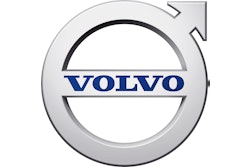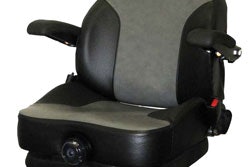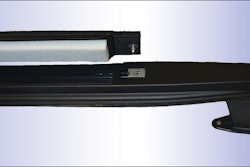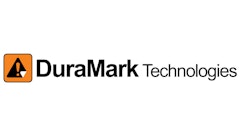
Volvo Construction Equipment (Volvo CE) recently invited OEM Off-highway to Sweden to discuss future technology developments in the construction machinery market. They shared with us paradigm shifts that will create revolutionary changes in machine design.
Never before has the research and development department been so vital to an OEM’s future success. Engineers will play a key role in the rapidly changing construction equipment landscape. “We need them because we have three paradigm shifts coming for the construction industry,” says Jenny Elfsberg, Director of Emerging Technologies, Volvo Construction Equipment. These paradigm shifts will happen whether a company prepares to address them or not.
The paradigm shifts
#1: System decoupling
The industry will transition from mechanically and hydraulically coupled systems in the machines to disconnected systems that talk to each other electronically. This can eliminate many hoses, pipes, gears and converters that add cost and waste. “We will do this because we want to eliminate losses in our machines,” says Elfsberg.
Think about a conventional powertrain. “Normally a complete driveline has a lot of things coupled together,” notes Elfsberg. “By decoupling the systems into more disconnected subsystems, we have building blocks to create a customized machine for the customer.”
For instance, the engine can be decoupled from the transmission, which would mean engine speed and wheel speed would no longer be dependent on each other. This allows more freedom in how the engine is operated. Another example of decoupling would be electric hybrid technology, where the engine serves as a generator, which is decoupled from all other machine systems.
#2: Intelligent machines
“The next paradigm shift is machine intelligence,” says Elfsberg. “This is connected to the decoupling [paradigm]because when we take parts of the subsystems and make them talk to each other through a computer, the machines can get smarter.”
Increased machine intelligence is needed for two reasons. The first is an operator in a decoupled machine might not be able to listen to the engine speed to understand how much is being demanded from the machine. “The machine will be optimized to work at the sweet spot for the engine. So you will not get the mechanical and hydraulic feedback that you get in a conventional machine. We need the intelligence to make the right decisions for the complete machine while you are operating it.”
The second reason for increased machine intelligence is increased customer value. Machine intelligence allows new solutions such as automated features that decrease operator fatigue. Consider the example of parking assist in the automotive industry.
Machine intelligence continues the journey toward full vehicle automation. However, Elfsberg doesn’t believe that the construction industry will see full autonomy in the near future. “But, we know if we move in that direction we will provide customers with the value that they would like to have.” Electronics technology can help automate functions such as grading. “Perhaps the operator is simply in charge of the direction of the vehicle’s movement and the software determines the grading adjustment needs, or the operator may interface directly with the percentage of slope desired. There are many possible applications for intelligence in off-road equipment.”
#3: A total solution
The third paradigm shift is toward the total solution. “We have been talking for quite a few years about being a total solution provider, which means going from selling a paver, an excavator or any machine to selling a solution,” explains Elfsberg. It is not enough to simply build the best excavator or wheel loader, an OEM must provide the most effective total solution to the customer. “That is the direction we need to go to develop the right technology solutions,” she says, The customer is interested in building roads or moving material. They want solutions that can help reduce cost and increase productivity. This may require machines and services to be combined in unique ways to offer the best solution. “This is already happening in the industry.”
OEMs can ignore these paradigm shifts at their own peril. “We want to secure our sustainability,” notes Elfsberg. “If we did not comply with the paradigm shifts, we would be out of business because [our] competitors are seeing the same paradigm shifts.”
She adds, “We can survive the three paradigm shifts because we focus every day on being innovative and bringing new things to the customer. In Volvo CE we understand that innovation is not easy to manage.”
A good first step is to understand the definition of innovation. “I have been working with technology development all of my career, and a lot of engineers believe that innovation and inventions are the same thing,” says Elfsberg. “But you can develop solutions that are totally irrelevant to your customers, and that is not seen as innovation. You need to add value to the customers in order to be an innovator. In order to accomplish this you first have to understand the customer and then you have to understand what the value is.
“When it comes to innovations, the ones that we want to catch are the ones that make a difference for the customer,” she adds. “That is very important to manage.” It is easy to develop a long list of ideas and then nothing happens. Technology development is a lean process. “We do not get unlimited resources, so we are in the process of being selective. We need to be conscious to not only choose the incremental improvements—which will be visible and make sense to the customer, but only bring small improvements—and the projects that are risk taking, the radical game changers in the industry. We need to invest in these products as well, otherwise someone else will do it. We need to balance incremental and radical.”
Applying paradigm shifts to transmission technology
All of these principals and the realization of the paradigm shifts can be seen in Volvo’s vision of future wheel loader driveline design, which is closely tied to fuel efficiency, according to Gunnar Stein, Global Director of Driveline Systems at Volvo Construction Equipment.
Volvo currently has an arsenal of current and future driveline technologies under development that take into account the customer’s return on investment. This is impacted by both the productivity (measured in tons per hour) and the fuel efficiency (how much material you move with a certain amount of fuel).
“We need to work on both aspects at the same time to really make a difference in the pocketbook of our customers,” says Stein. To that end, he presented four technical solutions that offer a progression of fuel savings up to 50% off the baseline standard four-speed powershift transmission with a torque converter. It is important to remember that each technological jump also comes with increased upfront costs. So the savings generated need to offset the additional costs in a timely fashion before it makes sense to make the next leap forward.
Adding intelligence
In 2009, Volvo made its first leap in technology over the current baseline powershift transmission with OptiShift. “One feature that we have in the OptiShift is the lock-up clutch in the torque converter,” says Stein. “The torque converter has a lot of losses in it. The other function is the Reverse-By-Braking function.”
With a conventional wheel loader, when you shuttle from reverse to forward, you want the machine to slow down and then accelerate in the other direction. “When you are slowing down the vehicle, the typical way is you engage the reverse gear with a clutch slowly,” says Stein. “Basically your engine feels like it is driving forward but you are actually decelerating the machine. That is burning fuel.”
OptiShift uses electronic technology to accomplish this task in a more efficient manner. It uses the brake pedal to slow the vehicle down so the engine only has to accelerate in the opposite direction. But it is seamless to the operator. “He just pushes the reverse button and the machine will slow down and accelerate again. So the operator doesn’t feel anything.” Yet the technology yields an average 15% savings in fuel over the baseline.
Decoupling engine speed and wheel speed
Stein adds, “The next step in technology could be the Continuously Variable Transmission (CVT).” It offers a totally stepless function. “Four-speed powershift transmissions have four discrete speeds, [so] you are somewhat limited in how you operate the engine.”
The CVT discussed was a hydrostatic power splitting transmission. “We have the engine that generates the power,” explains Stein. “Then we split it in two. One is the mechanical part. The mechanical part has the advantage of high efficiency – up to 96%.” The other part is hydrostatic. “The hydrostatic part has the advantage of the CVT functionality, the stepless functionality. So we combine the best of both worlds, which is technically complicated, but in essence that is all we do. The power is combined again and transferred to the wheels.
“We are actually able to decouple the wheel speed from the engine speed, which has major advantages in the loading cycle,” he adds. Consider that you can produce a map of how each engine performs in any given application with engine speed on the X axis and engine torque on the Y axis. This helps identify high fuel consumption areas. The goal is to avoid high fuel consumption areas, which tend to be during higher engine speeds. “By decoupling the engine speed from the wheel speed we have more freedom of selecting how the engine is operated. We can cut off some areas of the engine map completely. That would avoid the high fuel consumption areas. Then we want to operate the engine in those low fuel consumption areas.”
Another advantage of the CVT is it doesn’t have a torque converter. “The torque converter is actually a machine element that is not very efficient,” says Stein. “We needed it in the classical technology in order to supply torque while the vehicle was at a standstill. In this situation it doesn’t do any work, it only heats up oil. We don’t want that.” But the biggest benefit is the CVT promises to cut fuel consumption by 25% versus the baseline.
“Twenty-five percent is a lot better than we do today, but there is even more potential,” notes Stein. “Now we are looking farther into the future and more technical complexities.”
A totally disconnected system
The next step that can be taken is hybrids – either hydraulic or electric. “We have chosen electric hybrids to be our example,” says Stein. “You have a totally disconnected system architecture. You have an engine and you have a generator connected to it. It is really working as a generator. There are really no direct connections to wheels anymore or direct connections to the hydraulics. It has an electric motor connected to the transmission and electric motors connected to the hydraulics as well.”
With a totally disconnected system you can run the engine speed totally independent of wheel speed and hydraulics. “You can really optimize the total system so the engine is operating in those areas of lowest possible fuel consumption,” notes Stein.
Then there is an energy storage device that could be either a battery or a super capacitor. “The energy storage device makes it possible to take a smaller engine and boost with electrical energy during part of the cycle,” explains Stein. There is a power spike when the wheel loader enters the pile and fills the bucket. “This is where the big fuel consumption is happening because it is taking so much power out of the engine. But in the rest of the cycle the engine is actually not used to full power. The average power demand is only 60%. So we have to install a big engine in a wheel loader to be able to curl the bucket at the right time.”
But the engine is not being used to its full extent. “By introducing an energy storage device we can use the areas where the power is not fully used to charge the storage device and boost in the areas where demand is highest. Of course that drives up technical complexity and that doesn’t come for free.” But the result is a 50% fuel savings from baseline.
A new architecture
“The next interesting thing if we look even further into the future is that we go to a totally different architecture on the driveline components,” says Stein. “You could take away the transmission and axles and replace them with something like an electric wheel motor. If you go to completely disconnected systems you could go to an electric wheel motor. That enables a totally different machine configuration.”
So when might we see some of these innovations. “The customer will decide,” says Stein. “There are some factors that Volvo cannot change – for example, the fuel price. The whole idea of moving to these technologies is that we save total cost of ownership. The whole technology will come with a price tag. We need to offset that price with fuel savings. Our customers are business driven. There needs to be a return on investment in a certain time period. Those factors that contribute to this return on investment are not so much in our hands. We can work the other end of the equations.”

















![Hcm Ax Landcros Press Release[32] jpg](https://img.oemoffhighway.com/mindful/acbm/workspaces/default/uploads/2025/11/hcmaxlandcros-press-release32jpg.mAEgsolr89.jpg?ar=16%3A9&auto=format%2Ccompress&fit=crop&h=135&q=70&w=240)